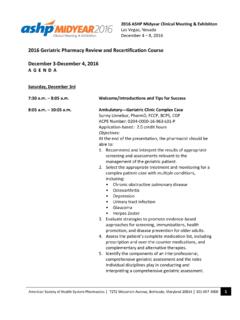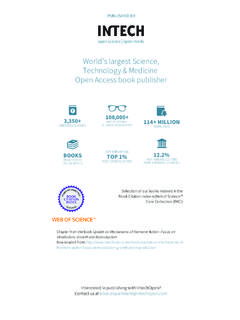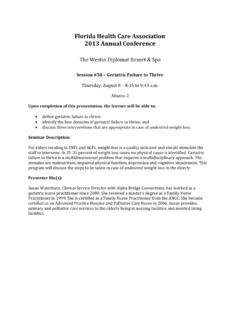Transcription of CBL COMPUTER BASED LEARNING Geriatric Medicine
1 1 CBL | COMPUTER BASED LEARNING Geriatric Medicine SECOND EDITION Second Edition: Edited by Jonathan M. Flacker Contributors: Manuel A. Eskildsen, Jonathan Hsu, Thomas Price, J. Lisa Tenover Emory University School of Medicine Department of Medicine Division of Geriatric Medicine and Gerontology Atlanta, GA 2 Second Edition Cover photograph by Jeanne Robinson 2008, 2011cc-nc-nd Emory University School of Medicine This work is licensed under the Creative Commons Attribution-NonCommerical-NoDerivs License To view a copy of this license, visit or send a letter to Creative Commons, 171 Second Street, Suite 300, San Francisco, California, 94105, USA.
2 Permission is granted to distribute this work as long as a) it is unmodified and b) the copies are not sold without express permission of the authors. This workbook and its companion website were made possible by a generous donation from Mr. Milton Kramer and a grant from the Donald W. Reynolds Foundation 3 Table of Contents Introduction 5 Basics in Geriatrics Principles: The BIG 10 7 LEARNING Modules: 1: Delirium 9 Thomas Price 2: Dementia 15 Manuel A. Eskildsen 3: Falls 21 Manuel A. Eskildsen 4: Incontinence 27 Manuel A. Eskildsen 5: Medication Use 33 J. Lisa Tenover 6: Pain Management 41 Manuel A. Eskildsen 7: Hazards of Hospitalization 47 Thomas Price 8: Adult failure to thrive and Malnutrition 53 Thomas Price 9: Transitions of Care for Older Patients 59 Thomas Price 10: Palliative Care 65 Jonathan Hsu and Jonathan M.
3 Flacker Facilitator s Guide and Answer Key 71 4 5 Introduction The following workbook modules are self- LEARNING tools originally prepared for Medicine residents as a companion resource to our website at This workbook focuses on core Geriatric syndromes and problems that are likely to be encountered during the clinical practice of a family practitioner or internist. Each module is divided into four parts. The first is a clinical vignette illustrative of the topic. This is followed by a set of tasks that include reading a general overview of the subject, and working with several educational tools available on the companion website.
4 Finally, each module ends with a post-test with at least three boards-style multiple choice questions that will test your knowledge of the topic. Each of these modules is intended to be finished in around 60 minutes of uninterrupted time. References and key principles focus (the BIG 10 principles) are listed at the end of each module. The general objectives for this workbook are: 1. Identify key topics in Geriatric Medicine and increase your knowledge, BASED through a case- BASED format. 2. Describe the extent to which iatrogenic issues are part of the management of Geriatric syndromes. 3. Describe the multifactorial nature of most Geriatric problems.
5 6 7 BASICS IN GERIATRICS BIG 10 1. Aging is not a disease a. Aging occurs at different rates 1) Between individuals 2) Within individuals in different organ systems b. Aging alone does not generally cause symptoms c. Aging increases susceptibility to many diseases and conditions ( homeostenosis ) d. Aging people are heterogeneous some are very healthy, some are very ill 2. Medical conditions in Geriatric patients are commonly chronic, multiple and multifactorial a. Older individuals commonly have multiple chronic conditions, making management complex and challenging b. Acute illnesses are superimposed on chronic conditions and their management c.
6 Treatment for one chronic or acute illness can influence the management of other underlying conditions d. Multiple factors are generally involved in the pathogenesis of Geriatric conditions 3. Reversible and treatable conditions are often underdiagnosed and undertreated in Geriatric patients a. Older individuals, caregivers, and health professionals mistakenly attribute symptoms to old age b. Many conditions present atypically in the Geriatric population c. Systematic screening for common Geriatric conditions can help avoid undiagnosed, treatable conditions d. Geriatric syndromes are commonly undiagnosed and therefore not managed optimally, such as: delirium, gait instability and falls, urinary incontinence, pain, and malnutrition 4.
7 Functional ability and quality of life are critical outcomes in the Geriatric population a. Functional capacity, in combination with social supports, is critical in determining living situation and overall quality of life b. Small changes in functional capability ( , the ability to transfer) can make a critical difference for quality of life of older patients and their caregivers c. Standard tools can be used to measure basic and instrumental activities of daily living and overall quality of life 5. Social history, social support, and patient preferences are essential aspects of managing Geriatric patients a.
8 Understanding the patient s life history and preferences for care are critical (place of birth, education, occupation, family relationships, spirituality, resources, willingness to take risks and utilize resources for care, etc.) b. Living circumstances is critical to managing frail older patients 8 c. Caregiver availability, health, and resources are critical determinants of care planning for frail older patients 6. Geriatric care is commonly multidisciplinary a. Interdisciplinary respect, collaboration, and communication are essential in the care of Geriatric patients and their caregivers b. Various disciplines play an important role in Geriatric care; nursing, rehabilitation therapists, dieticians, pharmacists, social workers, etc.
9 7. Cognitive and affective disorders are highly prevalent and commonly undiagnosed at early stages a. Aging is associated with changes in cognitive function b. Common causes of cognitive impairment include delirium, Alzheimer s Disease, multi-infarct dementia c. Geriatric depression is often undiagnosed d. Screening tools for dementia, delirium, and depression should be used routinely 8. Iatrogenic illnesses are common and many are preventable a. Polypharmacy, adverse drug reactions, drug-disease interactions, drug-drug interactions, inappropriate medications all common b. Complications of hospitalization, such as falls, immobility and deconditioning can be serious and life-threatening 9.
10 Geriatric care is provided in a variety of settings ranging from the home to long-term care institutions a. There are specific definitions and criteria for admission to different types of care settings b. Funding for care in different settings varies and depends on many factors c. Transitions between care settings must be coordinated in order to avoid unnecessary duplication, medical errors, and patient injuries d. Integrated, multi-level systems provide the most coordinated care for complex Geriatric patients 10. Ethical issues and end-of-life care are critical aspects of the practice of geriatrics a.











